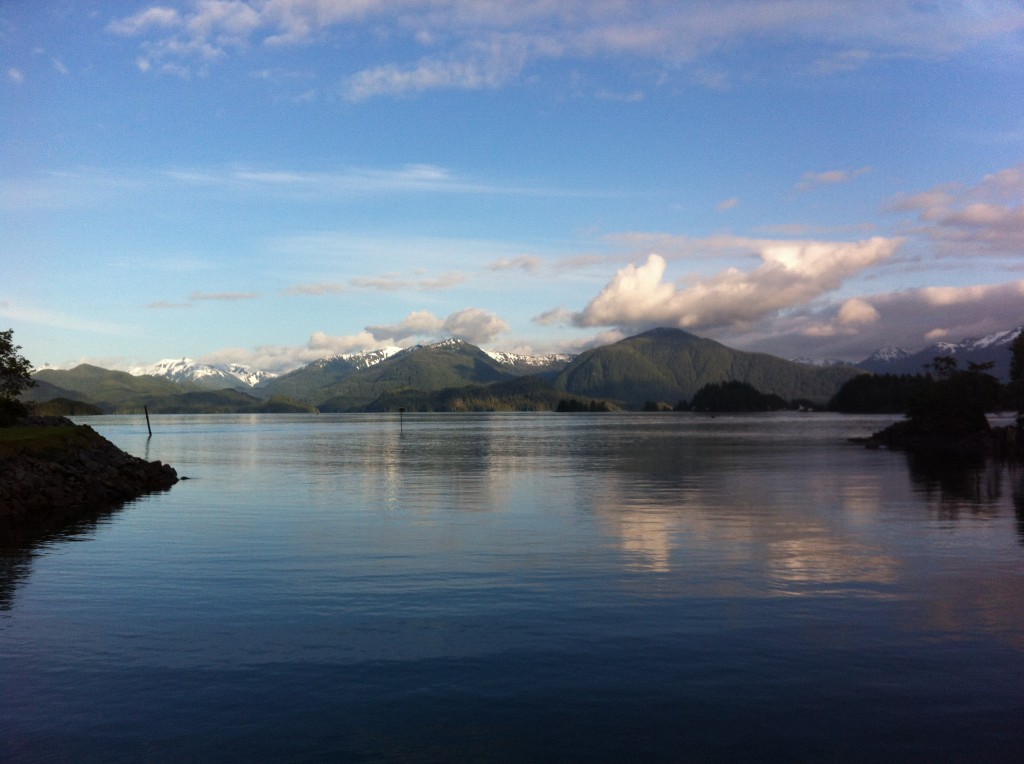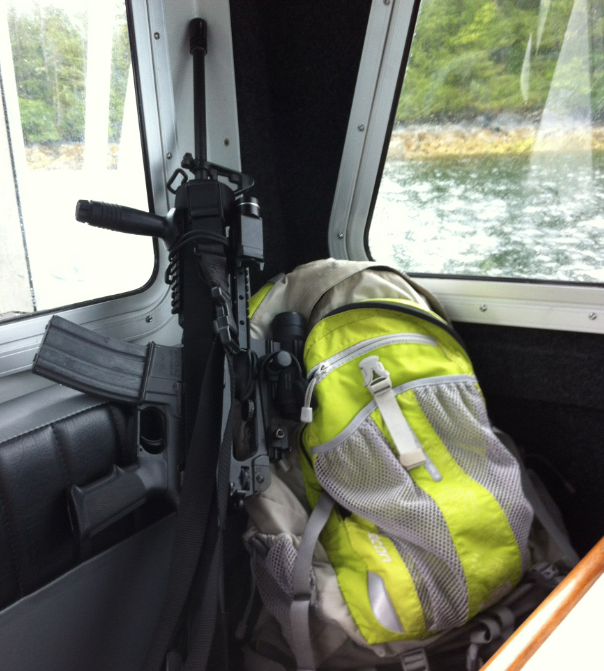Hello from the “Last Frontier,” as the license plates say. After several weeks of traveling, including a stopover at Rio+20, I’ve finally arrived in Sitka, Alaska, where I’m working with the US Forest Service in the Tongass National Forest.
I arrived here to a rainstorm and dinner with my boss, Clay, and his daughter at a sushi restaurant, where Clay proceeded to cut a piece of sashimi in half with his pocket knife. I also received an early warning from a ranger that bears sometimes use our driveway as a bed. I’ll be living in the Forest Service bunkhouse – which is less ‘bunk’ and more ‘house’ – with nine other seasonal workers. There are two floors, each of which has a full kitchen, living room, and, most importantly, laundry. When they’re not out in the field, the occupants of the house tend to congregate for communal dinners: my second night here, one of the guys barbecued salmon that he’d caught a few days earlier. On the whole, can’t complain.
Life moves slowly out here; even the pace of people’s speech is sluggish. I was sent home from work at 2 in the afternoon earlier this week because my boss was going fishing with a co-worker (the Forest Service operates on flex hours, so he’s not breaking any rules) –– and the next day he gave me an awesome ‘welcome’ gift of at least 6 pounds of fresh salmon steaks. House dinner the next night was as fantastic as you might imagine.

***
After two years of immersion in the United Nations, I came to Alaska to experience how local policy functions, and this has definitely been a quick introduction. I started by reading National Environmental Policy Act (NEPA) and Forest Service regulations –– Clay is the ranger in charge of lands, minerals, and special uses, which means that he makes decisions about projects that would affect forest lands.
Among the issues that we’ve discussed is a fish hatchery expansion, a project that will impact both marine and terrestrial environments and has therefore forced several different agencies, including the Army Corps of Engineers, to collaborate. In addition to the hatchery, the city of Sitka wants to expand a small hydroelectric dam installation, which would significantly impact the surrounding forest. The Forest Service has approved the plan, but with several conditions, including safety provisions and traffic management for construction periods. Unfortunately, the city only covered half the requirements in their proposal – and their ‘traffic safety’ plan is to close a road entirely for two years, which we’re a little skeptical about. So we’re sending it back to the city with a “gentle” request for re-evaluation.
We’ve also discussed a native corporation’s application to use a Log Transfer Facility (LTF), which has become a discussion about which governmental body owns rights over the shoreline and tidelands. The LTF is in the Tongass, meaning that it occupies federal land, and that’s where things get tricky. The corporation applied for an LTF use permit to the state of Alaska, which sent it over to the USFS. Unfortunately, the land that the LTF sits on is actually classified as ‘tideland’, because it’s below mean high tide level, and is therefore actually under state, rather than federal, jurisdiction. So the Forest Service had to send it back to the state, which then approved use –– pending the Forest Service’s further approval of usage of the 1.5 miles of logging road that are outside of corporation lands, still part of the forest, and above tideland level – and therefore still federal property. Still following?
(As an aside, it seems that legally the Forest Service could claim those tidelands for the Tongass, because the Parks Service has managed to claim them for Glacier Bay National Park. But because the Forest Service has never enforced its claim, if there was a dispute in court, the judiciary would interpret the law based on previous precedent –– meaning that the two services would be treated differently. The law, basically, is less immutable than subjective, entirely dependent on how it’s interpreted by an agency and then re-interpreted by other branches of government.)
What does this all lead to? The need for clarity! The devil really is in the details – what do agencies do in boundary regions (such as tidelands) where one border ends and another begins? Mother Nature just doesn’t place nicely with political borders. Perhaps she’s trying to tell us something.
***
Of course, we don’t spend all of our time quibbling over semantics. Other highlights of the first couple of days of work were a ‘family safety’ meeting, where we discussed exploding cigarette lighters and proper lighter usage procedures (a pilot apparently had one pop open due to the pressure change, so they’ve replaced all emergency kit lighters with BIC brand ones) and Clay harassing a fellow ranger about breaking his chainsaw. And yesterday Clay and I hopped in a boat with Forest Service law enforcement to camera trap an illegal cabin that someone built on a small island.

I’ve also spent plenty of time in Sitka, a remarkably relaxed town. XtraTuf boots are standard footwear at every occasion, from window-shopping to Saturday night bar-hopping (or as much bar-hopping as you can do with four bars), which will no doubt horrify fashion-inclined readers. Bikes are common, much as in New Haven; here, though, they’re rarely locked. Other than that, Sitka is pretty much what you’d expect from a fishing town with one main street and a population of approximately 9,000, though it also has a vibrant arts scene, a strong NGO presence, and many, many seasonal workers, who tend to create their own little communities. Being part of that community for a few short (too short!) weeks is the best bonus to a summer internship I could have asked for.
I’m off to the field tomorrow for nine days –– we have a boat trip around Baranof Island to inspect various sites along the way. In addition to me and Clay, we have an archeologist, a botanist, and a wilderness ranger along for the ride. Clay said it might very well be the trip of a lifetime, so I’ll no doubt have plenty to write about when I return. In the meantime, I’m off to meet up with the Yale School of Forestry’s very own Professor Karen Hebert, who I recently learned is also in town.